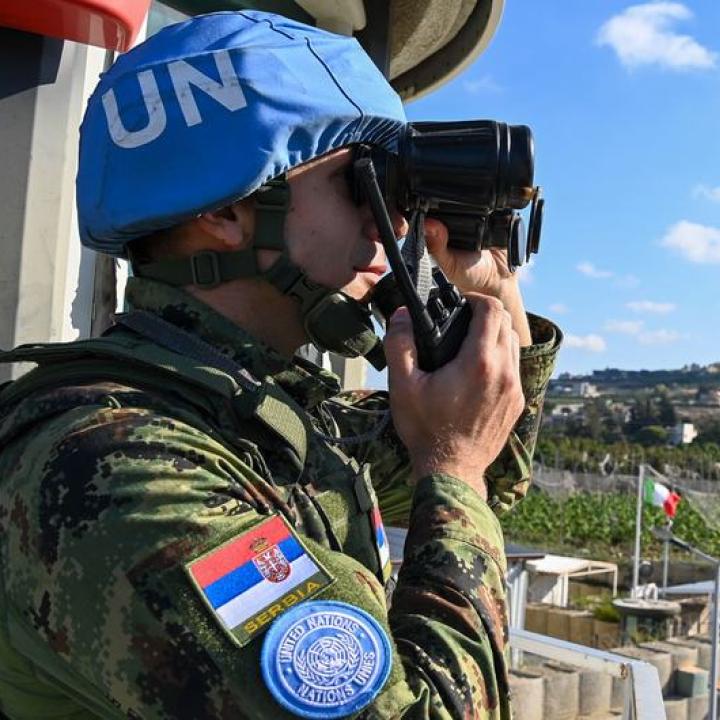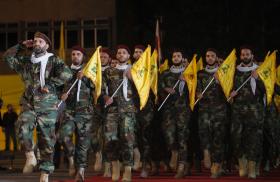
- Policy Analysis
- PolicyWatch 4026
Lebanon-Syria Border Talks Can Restrain Hezbollah and Boost Security

By encouraging the new Saudi-mediated talks with Damascus, Washington and its partners can help secure Beirut’s sovereignty, contain Hezbollah smuggling, and stabilize Lebanon’s other border with Israel.
On March 28, Lebanese defense minister Michel Menassa and his Syrian counterpart Murhaf Abu Qasra met in Saudi Arabia to sign an agreement on demarcating their shared border and boosting bilateral security coordination. The talks were spurred by intense clashes between Syrian army forces and Hezbollah elements.
Although the two newly installed governments have not yet drawn the final border, the agreement marks an important first step toward that goal. More specifically, Menassa and Abu Qasra committed to establish bilateral “legal and specialized committees” and activate “coordination mechanisms to address security threats.” What will this pledge mean in practice, and what obstacles will they face in reaching a permanent border agreement?
From the French Mandate to Hezbollah Smuggling
Demarcating the Lebanon-Syria frontier has long been a controversial issue—one that both the Assad regime and consecutive governments in Beirut consistently dodged after the 2006 Hezbollah-Israel war. In fact, the lack of a concrete border goes back to the end of the Ottoman era in 1916, when the Sykes-Picot Agreement granted the areas that would become modern Syria and Lebanon to the French, who in turn divided their mandate into entities with vague boundaries. Some parts of the border were drawn in 1934, but many stayed undefined. Later, the Assad regime refused to demarcate the border because it did not officially recognize Lebanon as an independent state, considering it part of “the greater Syria.”
For its part, Hezbollah saw no value in pushing Beirut to draw a border because a porous frontier was more useful for its rampant smuggling of drugs, money, weapons, and other material. This activity has only increased of late, with Hezbollah becoming more desperate for outside help amid the fall of its regime partner in Damascus, the closure of Iran’s “land bridge” to Lebanon, and the major military setbacks inflicted by Israel. Today, the border with Syria is reportedly pitted by 130 illegal crossing points, including 53 near Hezbollah’s Beqaa Valley stronghold. Indeed, the group is exploiting the fluid security situation by continuing its production and smuggling of Captagon at locations in south Syria, with Damascus recently announcing the breakup of twenty drug cells (some run by Hezbollah, some by Assad remnants) and six other cells focused on weapons smuggling. The heightened cross-border activity has in turn led to escalating clashes with forces from the new Syrian government. Hezbollah’s growing financial challenges will likely spur it to increase Captagon production inside Lebanon as well, making the Syrian smuggling points even more useful as potential export routes if the border is left unsecured.
Meanwhile, Lebanon has formed a new government that promises to implement international resolutions regarding its various border disputes. These include UN Security Council Resolution 1680 (2006), which called on Syria “to respond positively” to Lebanon’s request “to delineate their common border,” establish “full diplomatic relations” and address concerns about the “movements of arms” to Hezbollah and other nonstate actors. After the 2006 war, Security Council Resolution 1701 focused on the Israel-Lebanon frontier but also reaffirmed the need to implement Resolution 1680 and demarcate the Lebanon-Syria border, all toward the broader goal of asserting state authority over all Lebanese territory. These provisions remain crucial today, not only to prevent further border clashes with Syria, but also because Hezbollah is still trying to rebuild its arsenal and financial networks. Border demarcation could also help the new government in Damascus by curbing the movement of Hezbollah elements and Assad regime remnants across the currently wide open frontier.
The process of drawing the border will be particularly tricky because this frontier is full of overlapping towns and mixed populations stretching along roughly 375 kilometers (233 miles) of partially demarcated territory. Even today, one can find Lebanese communities on Syrian land and Syrian communities on Lebanese land, hearkening back to the days before any borders were officially established. Moreover, some of these villages overlap, like Wadi Khaled, Tfail, al-Qusayr, and Hawsh al-Sayyed Ali.
Despite these challenges, both of the new governments seem ready to confront the threats posed by Hezbollah and other pro-Iran groups. They also indicated their willingness to work on a maritime border during recent multilateral talks in Paris. And having a Saudi umbrella for such discussions is a boon, in terms of both coordinating further negotiations and ensuring accountability if any party tries to hamper the process.
The Shebaa Farms and “Resistance”
Perhaps the biggest barrier to successful border talks is the Shebaa Farms, which Israel has occupied since 1967. An agricultural strip along the borders of Syria and Lebanon, this area was never demarcated by the French mandate. The Assad regime maintained a vague policy toward the farms for decades, often stating in public that they were part of Lebanese territory but refusing to formalize this claim or relinquish its own claim by conveying this point to the UN in writing.
Notably, in a 2011 meeting with U.S. diplomat Frederic Hof, Bashar al-Assad privately admitted that both Shebaa Farms and the disputed hills outside Kfar Shouba were Syrian territory, not Lebanese. Yet keeping such views out of the public eye gave Hezbollah the perfect pretext to continue its “resistance” activities for years after Israel actually withdrew from Lebanese territory in 2000. As long as areas like the Shebaa Farms were not officially Syrian, the group could claim to be “liberating” Lebanese lands. Resolving the Shebaa dispute today could strip Hezbollah of this narrative.
To do so, the new government in Damascus would need to officially inform the UN that the Shebaa Farms are Syrian territory. If Lebanon does not oppose this claim, the issue would be formally resolved. Continued Saudi engagement would then be needed to ensure that Lebanon abides by international agreements and counters Hezbollah activities in the Shebaa area. Ultimately, however, monitoring this area and the rest of the Lebanon-Syria frontier will require deploying tens of thousands of properly equipped, trained, and paid border troops—a prerequisite that neither country is fully able to meet at the moment given their recent upheaval. As such, the United States and its partners will need to continue providing substantial assistance to the Lebanese military for now (see below).
Hezbollah Exploiting the Alawite Situation, Too
The porous border has also put Lebanon at risk of sectarian spillover from Syria. Following a spate of deadly clashes in their coastal towns, many Syrian Alawites fled to Lebanon, with more expected to arrive as sectarian tensions emerge in the Damascus area. Over 21,000 Syrians reportedly fled there in March alone, mainly to northern communities. Given the large number of Syrian refugees who previously crossed the border during the long civil war and never returned home, Lebanon’s collapsed economy cannot bear the additional burden. Assad regime remnants and other armed elements have reportedly crossed over as well and could eventually pose a security threat—especially since they are now residing in strictly Sunni areas such as Tripoli and Akkar, raising the risk of Alawite-Sunni sectarian clashes.
Perhaps most important, the fighting on Syria’s Alawite coast and along the border is strengthening Hezbollah’s narrative among its Shia base. During the latest conflict with Israel, more Shia became discontented with Hezbollah’s war decisions, lack of compensation for property losses, and failure to reconstruct Shia communities. Yet the sectarian killing of Alawites next door has given the group a golden opportunity to flip the narrative from domestic discontent to fear of Syria’s new Sunni Islamist rulers, despite lingering questions about which factions actually provoked and carried out the massacres. Hezbollah’s media machine is working to convince Shia that it remains the only actor willing and able to protect them, especially now that the new government in Beirut is calling for their disarmament. Assuaging these Shia fears will require securing the border—something that only the Lebanese state and its security forces can do, not Hezbollah.
Policy Recommendations
Although drawing an agreed border would be a big step toward improving the security situation, the new authorities in Lebanon and Syria need substantial outside resources and diplomatic help to finalize the deal, enforce the new lines, and contain Hezbollah smuggling and violence. Backed by the Trump administration, Saudi Arabia should expedite the process it began at last week’s meeting, pressuring both governments to resolve thorny issues like the Shebaa Farms dispute and overlapping territories. They also need to fully implement Security Council Resolutions 1680, 1701, and 1559, all of which require state authorities to prevent nonstate armed groups like Hezbollah from breaching the border. U.S. envoy Morgan Ortagus is reportedly headed to Lebanon as of this writing and should consider emphasizing these issues.
Absent sufficient troops, equipment, and salaries, however, the Lebanese Armed Forces will not be able to meet this mission or exert authority over the borders with Syria and Israel. Accordingly, the United States should continue its assistance to the LAF—albeit with clear expectations that the force must do what is necessary to secure the frontier even if that means confronting Hezbollah. International support for tougher border initiatives would be helpful as well, similar to the United Kingdom’s 2018 outlay to the LAF.
Drawing the border with Syria would also bolster Lebanon’s upcoming border talks with Israel, which Ortagus mentioned last month. Although formally linking the two discussions is not necessary, they are necessarily interdependent—implementing Resolution 1680 on the Lebanon-Syria frontier will not be effective unless 1701 and 1559 are implemented on the Lebanon-Israel frontier. Put another way, Israel’s border with Lebanon cannot be fully secured until Beirut secures its border with Syria.
Hanin Ghaddar is the Friedmann Senior Fellow in The Washington Institute’s Rubin Program on Arab Politics.



